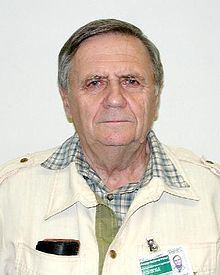Nationality Russian Fields Applied mathematics Name Sergei Godunov Notable awards Lenin Prize | Role Professor of mathematics Doctoral advisor Ivan Petrovsky | |
 | ||
Born July 17, 1929 (age 96)
Moscow, Russian SFSR, USSR ( 1929-07-17 ) Institutions Sobolev Institute of Mathematics, Novosibirsk, Russia Alma mater Moscow State University Known for Godunov's theorem
Godunov's scheme People also search for Victor S. Ryaben'kii, John Miller, Ivan Petrovsky Books Difference Schemes: An Introd, Elements of Continuu, Modern Aspects of Linear Al, Guaranteed Accuracy in Numerica, Ordinary differential equations | ||
Education Moscow State University | ||
Sergei Konstantinovich Godunov (; Russian: Серге́й Константи́нович Годуно́в; born July 17, 1929) is professor at the Sobolev Institute of Mathematics of the Russian Academy of Sciences in Novosibirsk, Russia.
Contents
Professor Godunov's most influential work is in the area of applied and numerical mathematics. It has had a major impact on science and engineering, particularly in the development of methodologies used in Computational Fluid Dynamics (CFD) and other computational fields.
On 1–2 May 1997 a symposium entitled: Godunov-type numerical methods, was held at the University of Michigan to honour Godunov. These methods are widely used to compute continuum processes dominated by wave propagation. On the following day, 3 May, Godunov received an honorary degree from the University of Michigan.
Godunov's theorem (Godunov, 1959) (also known as Godunov's order barrier theorem) : Linear numerical schemes for solving partial differential equations, having the property of not generating new extrema (a monotone scheme), can be at most first-order accurate.
Godunov's scheme is a conservative numerical scheme for solving partial differential equations. In this method, the conservative variables are considered as piecewise constant over the mesh cells at each time step and the time evolution is determined by the exact solution of the Riemann (shock tube) problem at the inter-cell boundaries (Hirsch, 1990).
